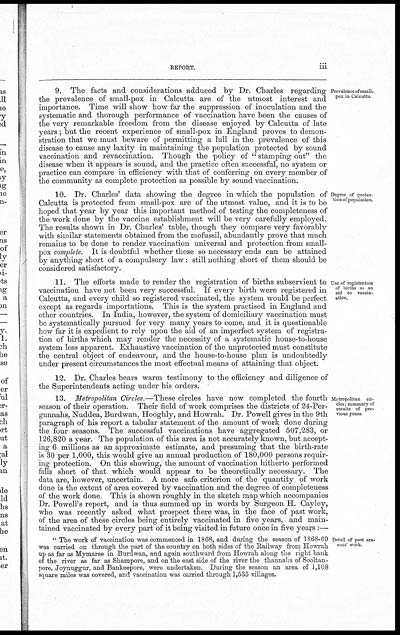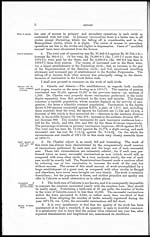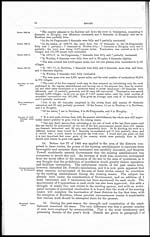Medicine - Vaccination > 1869-1873 - Report on vaccination in the Province of Bengal > Report on vaccination in the Province of Bengal for the year ending 31st March 1872
(219) Page iii
Download files
Individual page:
Thumbnail gallery: Grid view | List view

REPORT. iii
Prevalence of small-
pox in Calcutta.
9. The facts and considerations adduced by Dr. Charles regarding
the prevalence of small-pox in Calcutta are of the utmost interest and
importance. Time will show how far the suppression of inoculation and the
systematic and thorough performance of vaccination have been the causes of
the very remarkable freedom from the disease enjoyed by Calcutta of late
years; but the recent experience of small-pox in England proves to demon-
stration that we must beware of permitting a lull in the prevalence of this
disease to cause any laxity in maintaining the population protected by sound
vaccination and revaccination. Though the policy of " stamping out" the
disease when it appears is sound, and the practice often successful, no system or
practice can compare in efficiency with that of conferring on every member of
the community as complete protection as possible by sound vaccination.
Degree of protec-
tion of population.
10. Dr. Charles' data showing the degree in which the population of
Calcutta is protected from small-pox are of the utmost value, and it is to be
hoped that year by year this important method of testing the completeness of
the work done by the vaccine establishment will be very carefully employed.
The results shown in Dr. Charles' table, though they compare very favorably
with similar statements obtained from the mofussil, abundantly prove that much
remains to be done to render vaccination universal and protection from small-
pox complete. It is doubtful whether these so necessary ends can be attained
by anything short of a compulsory law: still nothing short of them should be
considered satisfactory.
Use of registration
of births as an
aid to vaccin-
ation.
11. The efforts made to render the registration of births subservient to
vaccination have not been very successful. If every birth were registered in
Calcutta, and every child so registered vaccinated, the system would be perfect
except as regards importations. This is the system practised in England and
other countries. In India, however, the system of domiciliary vaccination must
be systematically pursued for very many years to come, and it is questionable
how far it is expedient to rely upon the aid of an imperfect system of registra-
tion of births which may render the necessity of a systematic house-to-house
system less apparent. Exhaustive vaccination of the unprotected must constitute
the central object of endeavour, and the house-to-house plan is undoubtedly
under present circumstances the most effectual means of attaining that object.
12. Dr. Charles bears warm testimony to the efficiency and diligence of
the Superintendents acting under his orders.
Metropolitan cir-
cles ; summary of
results of pre-
vious years.
13. Metropolitan Circles.—These circles have now completed the fourth
season of their operation. Their field of work comprises the districts of 24-Per-
gunnahs, Nuddea, Burdwan, Hooghly, and Howrah. Dr. Powell gives in the 9th
paragraph of his report a tabular statement of the amount of work done during
the four seasons. The successful vaccinations have aggregated 507,283, or
126,820 a year. The population of this area is not accurately known, but accept-
ing 6 millions as an approximate estimate, and presuming that the birth-rate
is 30 per 1,000, this would give an annual production of 180,000 persons requir-
ing protection. On this showing, the amount of vaccination hitherto performed
falls short of that which would appear to be theoretically necessary. The
data are, however, uncertain. A more safe criterion of the quantity of work
done is the extent of area covered by vaccination and the degree of completeness
of the work done. This is shown roughly in the sketch map which accompanies
Dr. Powell's report, and is thus summed up in words by Surgeon H. Cayley,
who was recently asked what prospect there was, in the face of past work,
of the area of these circles being entirely vaccinated in five years, and main-
tained vaccinated by every part of it being visited in future once in five years :—
Detail of past sea-
sons' work.
" The work of vaccination was commenced in 1868, and during the season of 1868-69
was carried on through the part of the country on both sides of the Railway from Howrah
up as far as Mymaree in Burdwan, and again southward from Howrah along the right bank
of the river as far as Shampore, and on the east side of the river the thannahs of Sooltan-
pore, Joynuggur, and Bankeepore, were undertaken. During the season an area of 1,108
square miles was covered, and vaccination was carried through 1,535 villages.
Set display mode to: Large image | Zoom image | Transcription
Images and transcriptions on this page, including medium image downloads, may be used under the Creative Commons Attribution 4.0 International Licence unless otherwise stated. ![]()
| India Papers > Medicine - Vaccination > Report on vaccination in the Province of Bengal > Report on vaccination in the Province of Bengal for the year ending 31st March 1872 > (219) Page iii |
|---|
| Permanent URL | https://digital.nls.uk/91535280 |
|---|
| Additional NLS resources: | |
|---|---|




